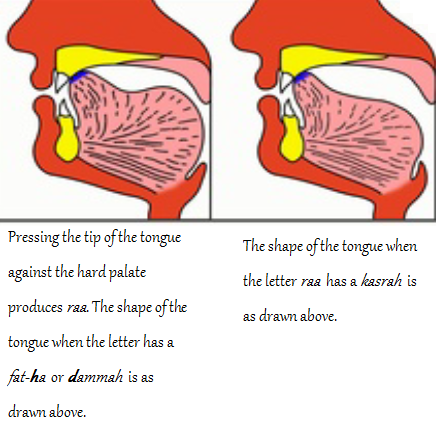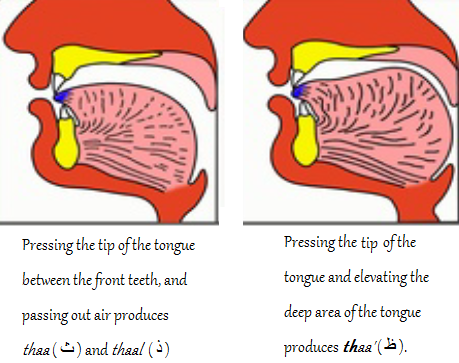Certainly, you’ve all been hard at work, stretching, pulling, warming up and cooling down with the previously mentioned Tongue Buffing Exercises: “Makhaarij Al-Huroof: Al-Lisaan”. Now it’s time to step it up and look at what you can do with the tip of your tongue.

![]()
Al-lisaan: contains makhaarij for 18 letters. These are divided across 10 points of articulation, which are categorised as 4 main areas. These are: Aqsal-lisaan; Wasat Al-lisaan; Haafat Al-lisaan; and Ra’sul-lisaan, or Tarful-lisaan. I’ve covered the first three areas in a previous post; below are the letters which emerge from Ra’sul-lisaan [1] (the tip of the tongue).
![]()
First, it is important to note that ra’sul-lisaan is the very tip of the tongue, and tarful-lisaan [2] is that small portion of the tongue just behind the tip. This is illustrated in the diagram below. This post covers both these regions as they are generally considered to be one main area.
Within this region, there are five points of articulation, producing 11 letters. These are:
![]()
6 – The Tip & Hard Palate
The very tip of the tongue, with that which coincides with it from the hard palate, behind the two front teeth produces the letter
Noon ( ن ), pronounced “nn”
with note that a ghunnah passes through the nasal passage to complete the sound for noon.
![]()
7 – The Tip, Upper Tip & Hard Palate
When the tip of the tongue, alongside a small area from the upper tip (tarful-lisaan), are pushed off the hard palate, the letter
Raa’ ( ر ), pronounced “rr”
is produced. The area referred to in the hard palate is slightly off that area which produces noon, as comparable in the diagrams above. The letters noon ( ن ), raa ( ر ), and laam ( ل ) are called Al-Ahruf Al-thalqeeyah [3]. Note: laam was covered in a previous post. The reason for this name is because they are produced from thalq al-lisaan [4], i.e. it’s tip.
Here’s food for thought: did you know that thalq also means “slip”. When your tongue “slips” and you let out a secret, it happens so fast. Thalq is just another characteristic of the tongue. It “slips”quickly after producing the consonant letter in a direction respective to a fat-ha, dammah, or kasrah.
![]()
8 – The Upper Tip & Hard Palate
Between the upper tip and hard palate, directly behind the two front incisors, the following letters are produced,
Taa’ ( ط ), pronounced “tt“
Taa’ ( ت ), pronounced “tt”
Daal ( د ), pronounced “dd”
With note that the letter taa’ ( ط ) leans against the front teeth slightly more than taa’ and daal because of the strength needed in producing its sound. These three letters are called Al-Ahruf Al-Natee‘ah [5] because they emerge from the “skin” i.e. nat’ or “gum” which covers the upper back of the front teeth.
![]()
9 – Between The Tip And Top & Bottom Teeth
Between the top and bottom teeth is an open area which is generally known to make a hissing sound. With the tip of the tongue, this area is also the makhraj for
Saad ( ص ), pronounced “ss“
Seen ( س ), pronounced “ss”
Zay ( ز ), pronounced “zz”
with note that when pronouncing these letters, the front sides of the tongue may touch some of the upper teeth. These three letters are named Al-Ahruf Al-Asleeyah [6], because they are produced from the very tip of the tongue
![]()
10 – The Tip & Front Incisors
Between the very tip of the tongue and the bottom edge of the two front teeth the following letters are produced
Thaa’ ( ث ), pronounced “thh”
Thaal ( ذ ), pronounced “th”
Thaa’ ( ظ ), pronounced “th“
These three letters are called Al-Ahruf Al-Lathaweeyah [7] because their point of articulation is very close to the gums of the two front teeth.
![]()
Resources Link:
– Makhaarij Al-Huroof document
![]()
Note, this document is found on the resources page.
![]()
Related Posts: Makhaarij Al-Huroof: Al-Jawf – Makhraj Al-Halq – Makhraj Al-Lisaan Pt 1 – Makhraj: Al-Shafataan – Makhraj: Al-Khayshoom
![]()
[1] رأس اللسان
[2] طرف اللسان
[3] الأحرف الذلقية
[4] ذلق اللسان
[5] الأحرف النطيعة
[6] الأحرف الأسلية
[7] الأحرف اللثوية






As Salaamu alaikum wa Rahmatullah,
I have my first exam in tajweed class coming up in a few days. These lessons in makhaarij are really helping me with the pronunciation of my most difficult letters. Maa shaa Allah, in particular, I really appreciate your thorough explanations and diagrams of the tongue placement . Many times when one listens to the sounds, they are not able to combine the two: pictures and sounds in order to derive the correct placement. The correct articulation can only be perfected with a qualified teacher, who will listen to you and make the corrections as you have said previously. This is the best advice. I pray that Allah facilitate you all and me, in succeeding to learn proper tajweed whereby we will be able to recite the Noble Qur’aan as it was revealed to the Prophet Muhammad, salalahu alaihi wa sallam and passed down to the righteous Companions, may Allah be pleased with them and later generations, aameen.
Aameen! Jazakumullahu khair for the lovely du’aa. All the best with your exam, I ask Allah to make it easy for you.
Assalamo Alaiki,
As regards pronunciation of Al-Ahraf Al-nataiyya, kindly explain whether the makhraj of “Taa” & “Daal” is exactly the same or there is a slight difference?
Thanking you,
With best wishes & highest regards,
Zahid Alvi
Dear Sister,
Assalamo Alaiki, While pronouncing the the letter “Daal”, may we consider that the tip of the tongue touches the gum behind the upper incisors,of the same gumline which covers the incisors, canines & the pre-molars (used for pronouncing the letter “Laam”),with tip & fronter edges of the tongue.
You are requested to please explain this point & intimate at your earliest convenience.
With best regards,